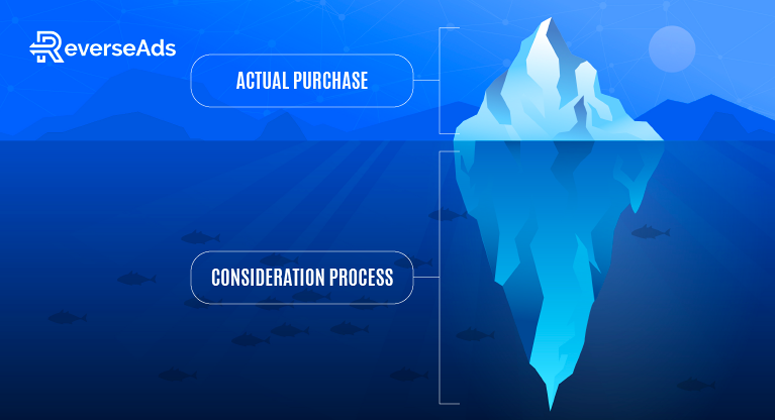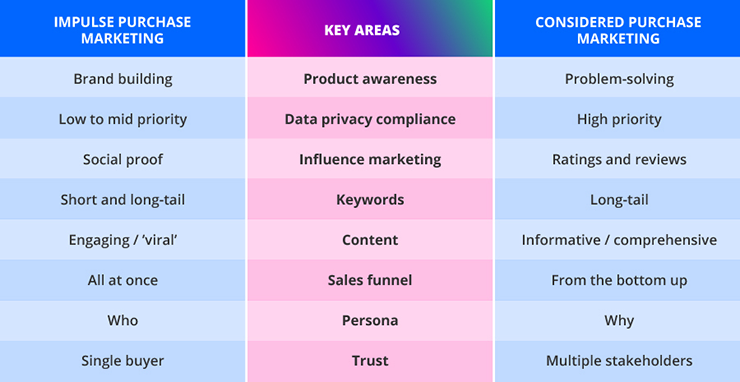Considering The Key Differences Between Impulse vs Considered Purchase Products’ Marketing

Considered Purchase Digital Marketing Strategies That Matter
A considered purchase process requires meaningful research and comparison by key decision-makers prior to a transaction. This process includes high involvement in the path to purchase from both the brand and the consumer, which then leads to both parties significantly benefiting from the purchase path with a high degree of financial and/or emotional risk and reward.
Marketers have predominantly considered B2B as the segment where almost every purchase is a considered purchase because of the inherently complex path to making a business decision. Technology has also democratized the way consumers make many purchase decisions, giving them more control over their purchase journeys, and resulting in paths to purchase that are much more complex.
This article explores why a deep understanding of the differences between impulse vs considered purchase marketing and multifaceted buying journeys allows marketers to effectively influence both business and consumer audiences as they take more time, seek more information and do more research on their paths to purchase.
In this article:
- The considered purchase customer journey
- Key differences between impulse and considered purchase marketing
- A true alternative to traditional search advertising for considered purchase brands

The Considered Purchase Customer Journey
Considering that the typical B2B new customer sales cycle would last 4-6 months, the industrial services category often uses considered purchase marketing strategies where the sales cycle is longer, the financial investment is higher and decisions include multiple stakeholders. This often requires a highly personalized marketing approach with various consumer touch points to close industrial service deals.
A healthcare decision falls into a considered purchase category; whether it’s a consumer searching for alternative cancer treatments or a B2B healthcare provider selling medical technology. Whether consumers are choosing a personal bank to handle their savings account or a financial group to handle a company’s merger and acquisition, the path to purchase is one made with thought and consideration.
By the time most B2B buyers search for a supplier, they would have already passed through the problem identification and purchase criteria stages. Therefore, providing the right technical information focused on supporting the search, evaluation or procurement stages are essential in the considered purchase decision process.
Although B2B buyers are often motivated to consider a product or service first based on price, other factors from the total cost of ownership to the role of the individual who is making the purchase decision are also important, especially at the higher levels of decision-making.
However, one size does not fit all. This is where understanding the key differences between impulse and considered purchase marketing can help marketers to tailor messages more effectively to their audiences.
Key Differences Between Impulse and Considered Purchase Marketing
Influencing a person to buy a pair of shoes requires a vastly different approach than the omni-channel marketing strategy required to influence a consumer to buy health insurance, or persuade a business to invest in a new software technology.
These complex considered purchase journeys require a specific approach that recognizes the journey, respects the investment and consequences of the purchase, and reinforces confidence in the buyer that your brand fits their selective criteria.
Compared to impulse buys, considered purchases take more time, research, review finding, price comparison, competitor study and planning. With further analysis and understanding of a consumer’s considered purchase path, businesses will be able to plug in the right marketing strategies in 2022 that are better aligned with B2B buyers’ needs and expectations.
The differences between impulse and considered purchases can be narrowed down to the following eight key areas:

1.Product Awareness
- During the process of a considered purchase, the consumer often starts their journey because of a particular pain point, or problem that arises. Once that pain point is identified, they begin to research and compare solutions for said problem, thus beginning their journey down the purchase path.
- Context is crucial during every stage of the journey — the marketer must deliver the right kind of content and information at the exact point the customer needs it.
- Unlike impulse buying marketing, focusing considered purchase messaging only on deals or sales doesn’t work because price is not the key motivator — fixing the problem is.
2.Data Privacy Compliance
- To protect the most valuable consumer data (their identification numbers and financial assets), GDPR, CCPA, and LGDP enacted a set of security protocols that the financial industry, including asset and wealth management businesses, needs to follow.
- These protocols are related to online advertising that enables higher data safety but also give consumers more control over their financial data.
- With the shift to the digital age and the emergence of electronic records, the demand for more secure data in the healthcare industry has only been higher.
3.Influence Marketing
- Reviews are more impactful for higher-priced and higher-consideration products.
- Considered purchase marketing doesn’t aim to overtly influence via social proof; rather, it instills confidence in the buyer through the quality of educational content, and quantity of ratings and reviews.
- By focusing on improving and leveraging consumer ratings and reviews, considered purchase brands gain credibility and can easily establish a process by which they garner more constructive reviews from happy customers.
4.Keywords
- When considering non-impulse purchases of $1000 and more, consumers will search for long-tail keywords that are specifically tailored to their needs, rather than generic keywords.
- Marketers need to identify specific niches for their considered purchase brands as buyers are willing to spend more time comparing specifications and prices on the open web before deciding on a quality niche product.
- Provide hyper-personalized advertising catered to a buyer’s unique intent and behavior on a considered purchase path to better incur the risks and costs of long-tail keywords.
5.Content
- Considered purchase buyers are looking to soak up as much information as they can before making their final decision.
- Both B2C and B2B healthcare audiences look to online content to educate themselves before making a healthcare decision. Unlike many industries, though, some healthcare-related content – experimental medical treatment, cell and gene therapies, birth control or recovery-oriented addiction services – can’t be advertised on Google at all, while others can only be advertised if the advertiser is certified and targets only approved countries.
- Optimize your product and services landing pages with comprehensive pricing, comparisons, details, images, how-to and explainer videos, rich blog content, or any other form of content so buyers can see exactly what they’re getting, and why it’s better than the competition.
6.Sales Funnel
- In a considered purchase funnel, there’s a higher risk of the buyer jumping out at any point where they feel like the brand isn’t solving their pain point or meeting their needs.
- Keeping a buyer fully engaged throughout their journey is of the utmost importance to a considered purchase marketer.
- The best way to understand how to communicate with your consumer is to understand those who purchased your product through research and data collection.
7.Persona
- Establish the “why” instead of the “who” of a considered purchase buyer persona.
- Understand how they view the problem, evaluate the solution and what will ultimately make them pull the trigger to make a purchase.
- Provide relevant information that speaks to their pain points rather than simply pushing features of your product or services that might not resonate.
8.Trust
- A considered purchase decision requires earning the trust of more than one decision-maker.
- Customers see through fake sales pitches and are looking for something real that they can experience.
- Considered purchase sales don’t happen because of the hype or the massive discount that they might get since consumers are in search of practical solutions that add value to their experience along the way.
A True Alternative to Traditional Search Advertising for Considered Purchase Brands
Understanding the key differences of impulse vs considered purchase marketing gives marketers the upper hand in diversifying their online advertising budgets to reach B2B buyers below the surface level of search. This brings us to another key difference; search advertising.
While traditional search advertising might work well for impulse purchases, search advertising actually plays a minor role for considered purchases. Rather than investing endlessly in an impulse medium that sits at the beginning of the consideration process, as buyers do with Google Ads, digital marketers should rethink traditional search advertising in order to truly deliver across the entire considered purchase consumer journey.
Research has also shown that these consumers are more inclined to spend the majority of their screen time beyond the “walled gardens” of Google and Facebook on their path to purchase. By finding each customer and plotting their non-linear path to purchase, digital marketers should be advertising to B2B buyers everywhere they go online at any stage.
ReverseAds’ patented keyword assignment model has consistently outperformed Google Ads 3-to-1 for considered purchase brands by allowing marketers to serve ads on the open web, where high-intent prospects are looking for engaging and relevant information related to a product or service niche, beyond simply clicking on annoying search ads.
Our keyword assignment algorithm collects and matches back anonymized data to predict what stage consumers are at and where they will go next, thus enhancing search ad campaigns with personalized ads being served in real-time for better conversion opportunities.
In a B2B marketplace that is now digital and buyer-driven, your team needs to reach the right accounts and buyers, when they’re ready to buy. Because buyers are using a full range of channels to do their own research and make decisions quickly, considered purchase marketers need to support the full buyer’s process and provide the right information at the right time.
Get in touch with us to personalize your 2022’s online advertising strategies toward a consumer’s considered purchase path.





